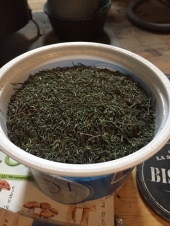This should help.
The leaves are stippled yellow by Spider Mites
Spider mites are tiny spider-like pests about the size of a grain of black pepper. They may be red, black, brown, or yellowish-white. Mites feed by sucking plant juices, removing chlorophyll and injecting toxins which cause small white dots on the leaves, discoloring and distorting them. Foliage of mite infested plants becomes stippled, yellow, and dry, and sometimes fine webbing is visible.
Spray plants with a forceful spray of water every other day for 3 days, to knock the mites from the leaves. If they persist, spray them with a natural insecticide such as an insecticidal soap or neem product according to instructions on its label.
For more information see the file on Controlling Mites
Identification
Culinary and aromatic herbs show signs of stress once they are infested with spider mites. Leaves begin to show discoloration and curling. Yellow and brown dots appear on otherwise healthy stock. The insects leave thread-like webs on the underside of leaves and stems of the plants. If you suspect a spider mite infestation, place a white piece of paper under several leaves and shake the leaves vigorously. If there is a proliferation of mites, they will fall to the paper and you will see movement.
Eradication
Once an infestation of spider mites is confirmed, you have many choices to rid your herb garden of the pest. Miticides are synthetic insecticides that kill on direct contact. While immediately effective, miticides are expensive and must be reapplied every five days. For a less toxic solution, choose rubbing alcohol or household detergent and mix it with water and spray it directly on the plant stem and underside of the leaves.
Mitigation
You can prevent spider mites from colonizing your herbs with a few best practices, known as integrated pest management. Keep clippings and weeds away from the soil surrounding your herbs. Select only the strongest stock and seed from the most reputable companies. Pinch or hand-pick any unwanted insects you see on the plant. Have a good plot plan and exercise crop rotation, pruning and removal of sick or infested plants. Blast spider mites out of your herb garden with a high-pressure stream of water once you see them on your plants.
Predation
There is a biological solution available for the organic gardener who prefers a more natural approach. Predatory mites eat other mites. Order phytoseiulus persimilis, metaseiulus occidentalis or phytoseiulus longpipes from mail-order nursery warehouses and these mites will not bother the plants. Instead, they just eat other mites. Many predatory mites are actually cannibalistic and will eat their own kind once all other food sources are gone.
Read more: Spider Mites on Herbs | eHow.com
http://www.ehow.com/info_8169819_spider-mites-herbs.html#ixzz1ssxREZfu


































































 1
1











